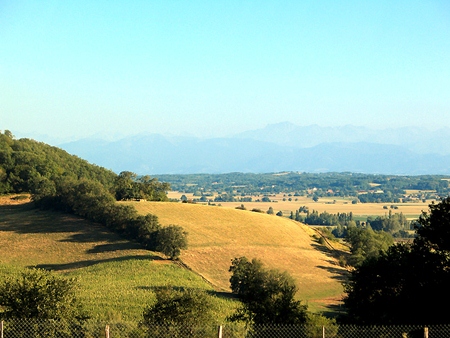We had a party at my place a couple of weeks ago and the catering company brought rather a lot of beef and onion pies, just like those you can find in the local supermarkets.
For some reason, they weren’t much of a hit with the guests, with the inevitable result that there were a lot of pies left over afterwards. Being a failed vegetarian, I rarely enthuse about these things, but they were actually quite good and provided sustenance for me and the dogs for several days afterwards.
 Gers, with the Pyrenees in the background. (Photo: Jean-Noël Lafargue)
Gers, with the Pyrenees in the background. (Photo: Jean-Noël Lafargue)
I tried one with a glass of Les Fumées Blanches Pinot Noir, a pleasant wine from the South West of France. This unlikely combination actually worked rather well, perhaps because the attractive “bite” of the wine made a pleasing contrast to the texture of the pastry.
Les Fumées Blanches Pinot Noir 2011, IGP Pays d’ Oc (red), France (Bt. 690 @ Wine Connection)
Jacques and François Lurton started producing wine in the Languedoc region of France over fifteen years ago, evidently attracted by its exceptional diversity and potential. With the support of a network of vine growers, they succeeded in creating an impressive range of wines.
Incidentally, the French word “fumée” usually means “smoke” but in this context it refers to the white morning mist which occurs in the cooler areas of the Lurton vineyards. The expression “IGP Pays d’Oc” basically means that a wine is guaranteed to be from a specific area. In this case, it’s the sunny Gers region in South West France, not very far from the Pyrenees Mountains. During the hot and dry summers, the vines are cooled by breezes from the Atlantic Ocean. Gers is also the home of Armagnac, the oldest brandy distilled in France. Pinot Noir (PEE-noh NWAHR) is the traditional red wine grape of Burgundy, now of course adopted in wine regions all over the world.
This wine is a vibrant cherry-red and has an elegant aroma of dark berries, herbs, cherries and a dash of spiciness. In the background, there’s a kind of smoky, distant smell of woodland. Even though the wine is completely dry, you’ll probably notice the distinctive taste of strawberries and cherries. It has a very smooth texture, but there’s quite an assertive firmness on the palate. It seems to have a slight touch of acidity too and there’s an exceptionally long, dry finish with a satisfying foundation of fine tannins. In some ways, this is rather a serious and elegant wine with plenty of character and interest. If you enjoy dry, firm reds with a good balance of tannin, you could well enjoy this one.
It takes a good forty-five minutes for the aromas and taste to open up, so for heaven’s sake don’t just open the bottle and have a swig. It will taste its best served cool and would make a perfect partner for Beef Bourguignon, grilled meats, game or veal and of course, meat and onion pies. It should work well with alpine cheeses like Emmenthal and Gruyère, or even slightly mature Camembert and Brie.
Georges DuBœuf Merlot 2010, IGP Pays d’ Oc (red), France (Bt. 499 @ Wine Connection)
This is a dark purplish wine with a seductive floral aroma of red and black fruit, cherries and a hint of herbs. There’s also a faint brambly, earthy kind of aroma in the background, which is fairly typical of Merlot. The wine is smooth and fruity on the palate with cherries and red currants up front; a lively cutting edge of refreshing acidity and a touch of firm round tannins. It’s quite light in texture and very dry, with a satisfying, long dry finish.
The label information is minimal, but the name Georges DuBœuf says it all. He was the founder of one of the biggest wine merchants in France, known especially for the production of Beaujolais. As a child, young Georges used to help in the family vineyards and used to crank the manual grape crusher when he was just six years old. I’ve tasted many of the excellent DuBœuf wines in the past, but I’d say this one is pretty well at entry level. In many ways, it’s a very attractive example of a southern Merlot, but to my mind a bit pricey for what you actually get.
It’s very much a food wine and would make a good partner for Italian-style tomato-based dishes, roast chicken or mushroom dishes. Being medium-bodied, it would go well with meat in red wine sauce or with casseroles. Pies too, since you asked.




